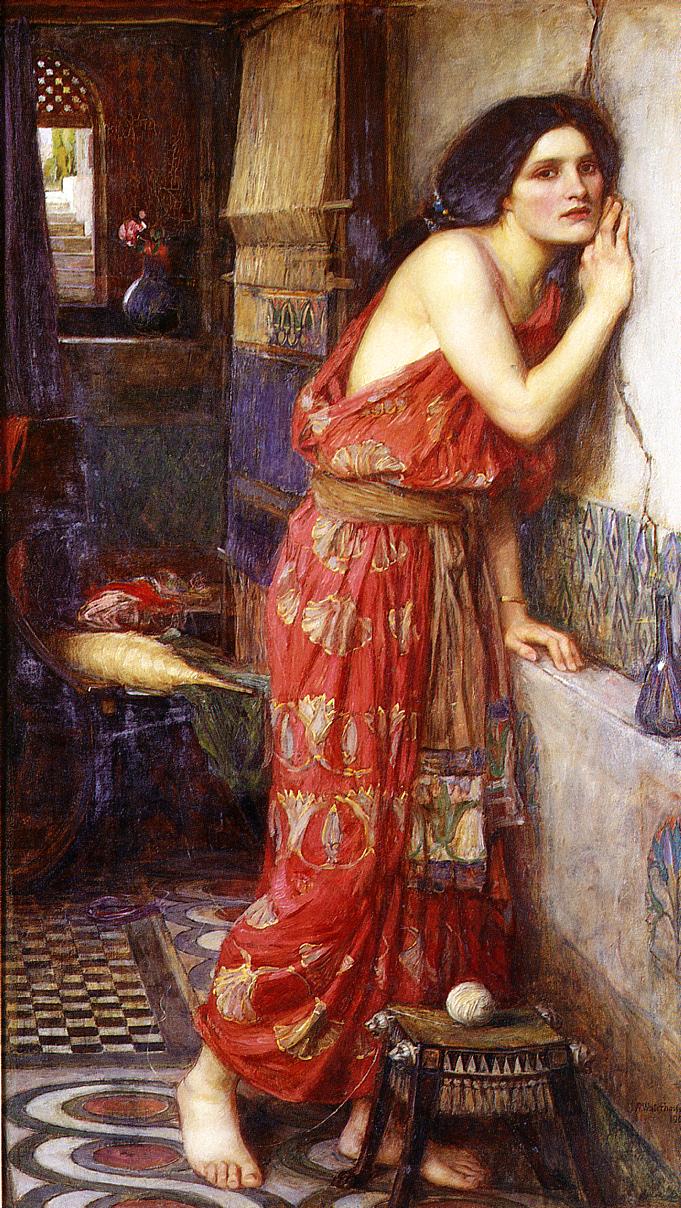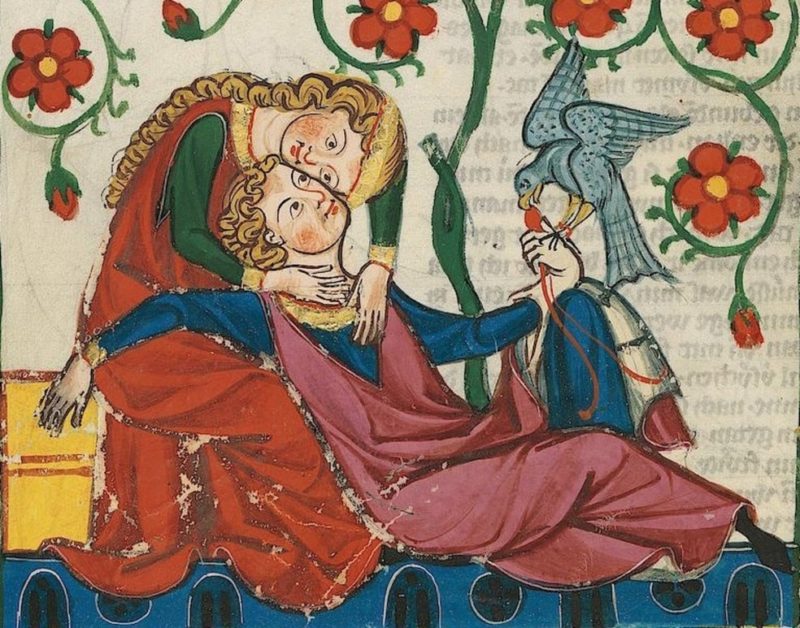
Ancient Texts Mentioned:
The Letters of Héloïse and Abelard
The Merchant’s Tale
Pyramus and Thisbē
Orpheus and Eurydice
Love Is Blind works like a Greek myth. Follow me: the story begins in 8 CE with a Greek poet named Ovid and his poem Pyramus and Thisbē. Pyramus and Thisbē are the original Western star-crossed lovers—forbidden to meet and thus fall in love via conversations had through a crack in the wall, never seeing one another, only their voices guiding and ensnaring their Two hearts into One. One day, Thisbē escapes and narrowly avoids death by lion; her fallen shroud remains behind. Pyramus finds the shroud and assumes Thisbē has died and, beset with grief, takes his life by his own sword. Thisbē returns for her shroud and finds her lover dead, kills herself, and kickstarts centuries of adaptations. The lesson: facing love is terrifying and yet we must pursue. I also think of Héloïse and Abelard, a nun and monk who are in love, who bear an illegitimate child they name Astrolabe after the cosmological mapping device (!) but who cannot be together because they agree marriage undermines the legitimacy of their love. Their care is instead expressed through a series of letters that expound philosophy, theology, feminism, and sex. For their indiscretion, Héloïse is transferred to a distant abbey and Abelard is castrated. Unmet love is about as fertile as a Benedictine eunuch.
The proverb “love at first sight” originates with Geoffrey Chaucer’s “The Merchant’s Tale.” The eponymous merchant says he knows all about marriage and suffering because he hates every second of his marriage. Therefore, he won’t bother with telling us about his marriage but another story, which happens to also be about marriage. He tells of a old bachelor knight named January. At age sixty, he asks his friends to find him a wife twenty-years-old or younger. The crux of the story rests on an argument between his friends on the pros and cons of marriage. Placebo tells January to marry a young wife, that a young wife will be more malleable to his wishes. Justinus, citing Seneca, argues that he should take a second to think this through, and at least choose a wife closer in age.

In the end, January marries May, who is in love with his squire Damian. As the years pass, January’s sight dwindles until he becomes blind. One day, May climbs a pear tree to have sex with Damian among the branches and, miraculously, January’s sight is returned just in the moment of penetration. But May convinces January that they are merely struggling, not fucking. And thus is born the metaphor, “For loue is blynd alday and may nat see,” January’s blindness to the deceit of love is the true blindness of his life.
“Love is blind” as an idiom was more greatly exposed by William Shakespeare, appearing in plays like Two Gentlemen of Verona, Henry V, and The Merchant of Venice. In the latter, Jessica, daughter of the Jewish moneylender Shylock and lover to the penniless Christian Lorenzo, opines:
Here, catch this casket; it is worth the pains.
I am glad ’tis night, you do not look on me,
For I am much ashamed of my exchange:
But love is blind and lovers cannot see.
Ultimately, Jessica chooses to convert to Christianity for the affair, betraying her familial line, falling into matrimony all the while quoting none other than Pyramus and Thisbē on a stroll amongst the gardens with her beloved.
Four-hundred-twenty-four-ish years later, the Netflix update, Love is Blind, follows singles on an “experiment” to determine whether or not the ancient proverb is true. The producers disregard that the title should instead be Is Love Blind, since it’s a not a fact, but a hypothesis. The participants go on a series of blind dates in “pods”—diamond-cut-shaped isolation rooms. They speak to one another through a thin, blue illuminated wall. Conversation topics range from favorite childhood books to Christian values. Watching this, one wonders, have these people ever had a meaningful conversation? How does one so easily make the leap from commonality and conversational flow to soul mate? Do they need a phone-a-friend? They exemplify commedia dell’arte innamorati—sincere, yet flamboyant in their unswerving commitment to the idea of love, and expressing themselves entirely in clichés. Only Jessica, the love-to-hate character, and serendipitous throwback to Shakespeare’s merchant’s daughter, seems capable, despite the constant flow of wine in metal goblets, of objective reasoning outside of platitudes.

To escape the pods, the couples must propose and accept marriage. Only then can they be released to Cancun, Mexico, where they then stay in a luxurious resort replete with private pools and chocolate-covered strawberries. Their dates include activities like horseback riding, cheeseboard picnics, and binge drinking. They meet in groups and covet thy neighbors’ match. From there they’re shuttled to nondescript, it not depressing, apartments in a shared building to see if they “survive in the real world.” Their biggest antagonist according to hosts Nick Lachey and Vanessa Minnello: social media. For not long is love blind, their chosen paramour may not survive pretty pictures of pretty potentials.
The ultimate question of the show is, will these people marry and thus prove love is blind, or will they not marry and prove love can’t exist if you examine it—recalling two other lovers of ancient Greece, Eurydice and Orpheus, who chooses to see his beloved, and as a consequence their love disappears. The entire premise of the show rests on the credence that Marriage is the End of The Story and that the end of the story is what we should all be after. And that divorce is apropos to the exuberant love of matrimony. It says, love is marriage and marriage is the only proof of love.
This marriage plot, a narrative device in which all directions point toward nuptials, issued from Regency era initiatives to boost a middle class and share the wealth of romance equitably among economic strata. Prior to sentimentalist novelists like Elliot, the Brontës, and Austen, love and marriage were represented only with characters of noble birth, while the commoners were relegated to farce. By bringing marriage to the plebes, the marriage plot aimed to elevate the 99% to serious moral subjects, all while espousing larger Church-wide control over couples and forging the iron thralls of a socio-patriarchal obsession with Western betrothal. The effects have deprived us all of more expansive options. It’s as boring to reiterate the divorce rate, which even the Romans bemoaned, as it is to privilege the minacious strictness of until death do thee part, but to continue to push marriage, as well as unmarried longevity, as the utmost emblem of love is plain aromantic and tangential to contemporary forms of care.

The most disturbing part of this show, however, is not its anachronism to a very short period of human relationship history, but the complete and credulous swallowing of a made decision; the contestants refuse to deviate from their course despite all doubt and obstacle. The humans, Jessica and Mark, Cameron and Lauren, Damian and Giannina, Carlton and Diamond, and Barnett and Amber, emerge after ten days from their pods wide-eyed in more ways then one—how long has it been since any of these people have had sex? to see for the first time their secret beloveds. Boners abound. Like lemmings, they’re willing to tumble for anything, even if they vault over the edge. On one hand it’s a testament to the intention of will; on another, it’s watching a form of obedience that feels like broken spirit.
Love is Blind is not concerned with its ending, but rather its own process. Over the course of the season, we witness a compressed version of the tumultuous assessment that all people go through as they embark on new relationships. For these five couples, they rapid cycle through doubt, elation, decline, conflict, doubt, elation, decline, and conflict in the span of five weeks before being forced to make a decision—will they or won’t they commit to saying I do? One root of the word “wed,” is the Proto Germanic wadja, meaning “to bet, wager,” suggesting that all pledges of everlasting love are a risk. They need nine episodes to determine whether or not they’ll follow through on their proposals, because why not wait until the climax to break a heart? The show ponders which is riskier, route one: the forced leap into uncertainty; or route two: dousing one’s delusions of the romantic flame.
In the finale, only two couples decide to wed: crowd favorites and emotional stalwarts Lauren and Cameron, and Amber Who Keeps It Real and Barnett of Few Opinions. The others are seemingly enlightened to the truth: this is insane and I have no idea who you are and you, Jessica, give your dog wine to drink and I am not okay with that! During the reunion episode, Amber admits relationship conflict at discovering Barnett may have insurmountable character traits that are incompatible with her own. She hints at infidelity, a bromide fissure in true love’s imagined shield. Lauren and Cameron have bought a “fur baby” and are commingling their two families. One out of five for love, not bad.
Still, plots that end in marriage need to feel deserved. We need our star-crossed lovers, adversity, and time, not someone who has drunk the champagne-spiked kool-aid and who is so obviously apprehensive of the marriage. Here we’re back to the every-person as farce, removed from status as moral subjectitude and once again made the clown, the fool, the butt. The show forgets that marriage is no joke, and it’s made a joke through these productions.
Syntax of the title aside, the show asks so much more than is love blind; it asks, How gullible is love? How gullible must we be to love? But love cannot be reduced to the pithy, over-generalized proverb; the only romance that is real is the one you are in. Here, I’m willing to come to a very Platonic conclusion: as represented in Love is Blind, love is indeed blind and such devotion should get out of the cave/pod and look back with eyes strapped agape—pillars of salt be damned—to espy romance in all its gorgeous terror. When asked if they agreed with the title’s stated hypothesis, is love blind, everyone, even those who said I don’t, raised their hands. Who knows what they haven’t seen.




